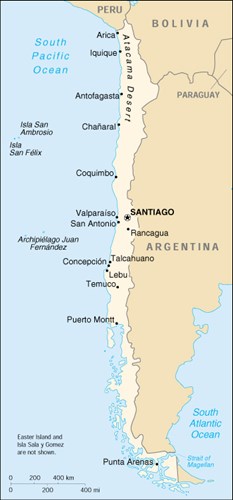Chile - Fluoridated Powdered Milk Programme
Chile - Fluoridated Powdered Milk Programme
Introduction
In 1994, the Institute of Nutrition and Food Technology (INFT) of the University of Chile, commenced a community programme to using powdered milk for delivering fluoride to a rural community with low fluoride concentration in its drinking water where water fluoridation may not be practical. This presentation is based on the study by Marino and co-workers, published in 2001.
Background and Rationale
In Chile, under the National Complementary Feeding Program (PNAC) every child is entitled to receive, free of charge, 2 kg of powdered cow's milk (Purita) monthly from birth till 2 years old. The child then onwards is entitled to 1 kg of milk derivative (Purita Cereals) per month till 6 years of age. The national coverage of the PNAC programme is 92%. Based on the wide coverage of the PNAC programme, the INFT initiated this feasibility study to use powdered milk as a vehicle for fluorides to a rural community.
Project Outline
The aim of the programme was to prevent caries in primary dentition of 3-6 years-old children in a rural community by using powdered milk as a vehicle for delivering fluoride. Two similarly matched communities were selected. Codegua, the test community lies 100 km south of Santiago, the Chilean capital. La Punta, the control community was 10 km north of Codegua. Children from both areas had to go to the Regional capital Rancagua for dental treatments except for emergencies.

Fluoridated milk and milk-cereal was given to about 1000 pre-school children in Codegua using the PNAC programme. The daily fluoride dose from the powdered milk was estimated as 0.25 mg for infants (0-2 years old), 0.5 mg for children aged 2-3 years and 0.75 mg for 3-6 years old children. Cross-sectional samples of children aged 3-6 years were taken from the test community in Codegua from 1994-1999 and from the control group La Punta from 1997-1999 and caries data collected.
Achievements
Significant reduction (72%) of caries prevalence (dmfs) was observed in the 3-6 years old children in Codegua, the test community, when the 1994 and 1999 caries data were compared.
Mean number of decayed, missing and filled primary tooth surfaces (dmfs) in 3-6-year-old children living in Codegua by year of data collection.
| Age (years) | 1994 | 1999 | Reduction (Percentage changes in indices) |
| 3 | 3.11 | 1.52 | 51% |
| 4 | 5.40 | 3.18 | 41% |
| 5 | 13.75 | 3.03 | 78% |
| 6 | 19.21 | 5.63 | 71% |
| 3-6 | 11.78 | 3.35 | 72% |
In 1999, the children in the study community showed significantly lower dmfs (41%) than children in the control community.
Mean number of decayed, missing and filled primary tooth surfaces (dmfs) in 3-6-year-old children living in Codegua and La Punta, 1999.
| Age (years) | La Punta | Codegua | Reduction (Percentage changes in indices) |
| 3 | 3.85 | 1.52 | 61% |
| 4 | 4.22 | 3.18 | 25% |
| 5 | 5.61 | 3.03 | 46% |
| 6 | 8.79 | 5.63 | 36% |
| 3-6 | 5.65 | 3.35 | 41% |
The proportion of caries-free children in Codegua the study community increased after 4 years of implementation of the programme from 22.0% to 48.4%.
Percentage of children free from dental caries by age: comparisons between 1994 and 1999 of the trial in the study community (Codegua);between 1997 and 1999 of the trial in the control community (La Punta) and between the study community and the control community (1999).
| Age (years) | Codegua | La Punta | La Punta | Codegua | |||||
| 1994 | 1999 | P | 1994 | 1999 | P | 1994 (%) | 1999 (%) | P | |
| 3 | 40.7 | 63.3 | <0.05 | 42.5 | 37.3 | NS | 37.3 | 63.3 | < 0.01 |
| 4 | 33.3 | 53.1 | <0.05 | 38.9 | 31.7 | NS | 31.7 | 53.1 | <0.05 |
| 5 | 21.8 | 50.0 | <0.01 | 23.1 | 33.9 | NS | 33.9 | 50.0 | NS |
| 6 | 3.8 | 27.4 | <0.01 | 16.4 | 16.1 | NS | 16.1 | 27.4 | NS |
| 3-6 | 22.0 | 48.4 | <0.01 | 28.0 | 29.6 | NS | 29.6 | 48.4 | <0.01 |
P value for percentage changes in indices
NS = Non-significant
Conclusion
Community water fluoridation usually does not reach rural areas in a country. Under Chilean rural conditions, fluoridation of powdered milk distributed using the existing PNAC programme is an effective caries prevention alternative for areas where water fluoridation might not be feasible.
References
Marino R, Villa A, Guerrero S. A community trial of fluoridated powdered milk in Chile. Community Dent Oral Epidemiol 2001; 29: 435-442.
